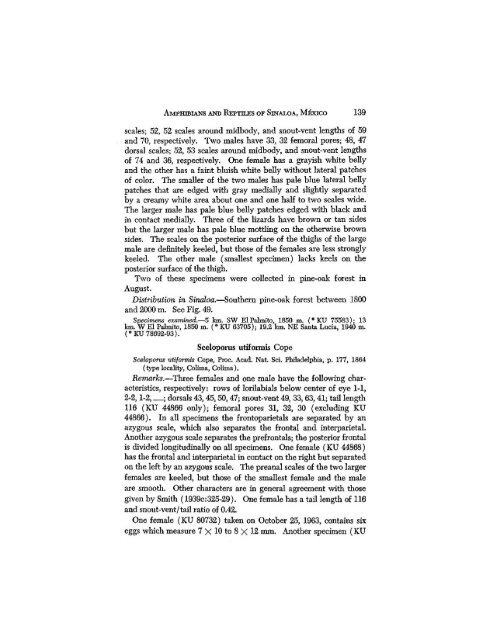The Amphibians and Reptiles of Sinaloa, Mexico - Smithsonian ...
The Amphibians and Reptiles of Sinaloa, Mexico - Smithsonian ...
The Amphibians and Reptiles of Sinaloa, Mexico - Smithsonian ...
Create successful ePaper yourself
Turn your PDF publications into a flip-book with our unique Google optimized e-Paper software.
AMPHIBIANS AND REPTILES OF SINTALOA, MEXICO 139<br />
scales; 52, 52 scales around midbody, <strong>and</strong> snout-vent lengths <strong>of</strong> 59<br />
<strong>and</strong> 70, respectively. Two males have 33, 32 femoral pores; 48, 47<br />
dorsal scales; 52, 53 scales around midbody, <strong>and</strong> snout-vent lengths<br />
<strong>of</strong> 74 <strong>and</strong> 36, respectively. One female has a grayish white belly<br />
<strong>and</strong> the other has a faint bluish white belly without lateral patches<br />
<strong>of</strong> color. <strong>The</strong> smaller <strong>of</strong> the two males has pale blue lateral belly<br />
patches that are edged with gray medially <strong>and</strong> slightly separated<br />
by a creamy white area about one <strong>and</strong> one half to two scales wide.<br />
<strong>The</strong> larger male has pale blue belly patches edged with black <strong>and</strong><br />
in contact medially. Three <strong>of</strong> the lizards have brown or tan sides<br />
but the larger male has pale blue mottling on the otherwise brown<br />
sides. <strong>The</strong> scales on the posterior surface <strong>of</strong> the thighs <strong>of</strong> the large<br />
male are definitely keeled, but those <strong>of</strong> the females are less strongly<br />
keeled. <strong>The</strong> other male (smallest specimen) lacks keels on the<br />
posterior surface <strong>of</strong> the thigh.<br />
Two <strong>of</strong> these specimens were collected in pine-oak forest in<br />
August.<br />
Distribution in <strong>Sinaloa</strong>.—Southern pine-oak forest between 1800<br />
<strong>and</strong> 2000 m. See Fig. 49.<br />
Specimens examined.—5 km. SW ElPaLnito, 1850 m. (•KU 75583); 13<br />
km. W El Palmito, 1850 m. ("KU 63705); 19.2 1cm. NE Santa Lucia, 1940 m.<br />
(°KU 78692-93).<br />
Sceloporus utiformis Cope<br />
Sceloporus utiformis Cope, Proc. Acad. Nat. Sci. Philadelphia, p. 177, 1864<br />
(type locality, Colima, Colima).<br />
Remarks.—Three females <strong>and</strong> one male have the following characteristics,<br />
respectively: rows <strong>of</strong> lorilabials below center <strong>of</strong> eye 1-1,<br />
2-2,1-2, ; dorsals 43,45,50,47; snout-vent 49, 33,63,41; tail length<br />
116 (KU 44866 only); femoral pores 31, 32, 30 (excluding KU<br />
44866). In all specimens the frontoparietals are separated by an<br />
azygous scale, which also separates the frontal <strong>and</strong> interparietal.<br />
Another azygous scale separates the prefrontals; the posterior frontal<br />
is divided longitudinally on all specimens. One female (KU 44868)<br />
has the frontal <strong>and</strong> interparietal in contact on the right but separated<br />
on the left by an azygous scale. <strong>The</strong> preanal scales <strong>of</strong> the two larger<br />
females are keeled, but those <strong>of</strong> the smallest female <strong>and</strong> the male<br />
are smooth. Other characters are in general agreement with those<br />
given by Smith (1939c:325-29). One female has a tail length <strong>of</strong> 116<br />
<strong>and</strong> snout-vent/tail ratio <strong>of</strong> 0.42,<br />
One female (KU 80732) taken on October 25, 1963, contains six<br />
eggs which measure 7 X 10 to 8 X 12 mm. Another specimen (KU
















